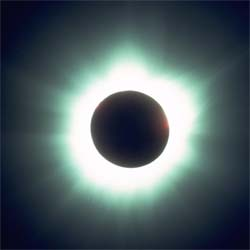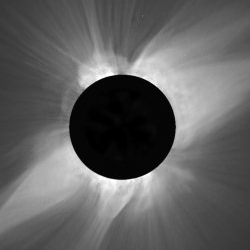

Sources:
Bottom Right: http://laserstars.org/spectra/Coronium.html
The invention of the spectroscope in 1859 allowed 19th century scientists to inquire into the chemical composition of the corona. After analyzing the spectrum of the corona during the 1879 solar eclipse, astronomers Charles Augustinus Young and William Harkness detected a green emission band of 530 nm that resembled nothing that had ever been observed on Earth. They hypothesized that the emission band was the result of an extraterrestrial element, which they coined "Coronium". Photographing an eclipse with a special solar camera allows the green glow of the corona to be observed (see the NASA picture, Bottom Left).
It was not until 1941 that the Swedish physicist Bengt Edlén discovered that the 530 nm band was the result of highly charged Iron ions. When Fe (XIII) is excited, it looses an electron (becoming Fe (XIV)) and emits the green light that characterizes the solar corona.
This discovery raised a new question. The oxidation of Fe (XIII) to Fe (XIV) can only occur in temperatures above one million Kelvin. This means that the corona is hundreds of times hotter than the surface of the sun (a measly 5778 K). How is that possible?
A number of theories have been proposed to explain the process of coronal heating. The earliest was the Wave Heating theory, attributed to Evry Schatzman in 1949. It suggests that waves from the interior of the sun carry energy to the corona by propagating through the coronal plasma, just as sound waves propagate through air. These waves are called Alvén waves, and are caused by flowing ions and shifting magnetic fields within the Sun. While computer simulations in the early 21st century revealed that Alvén waves are prevalent enough and can carry enough energy to be the source of coronal heating, no evidence of wave propagation through the corona has been directly observed.
An alternate explanation is Magnetic Reconnection theory. Magnetic reconnection occurs when magnetic fields from large, magnetized regions of the sun's surface induce electrical currents through the coronal plasma. The arcing currents are quickly dissipated and the energy is converted to heat. It is hypothesized that this is the same process is responsible for solar flares. The following photograph from the Solar Dynamics Observatory illustrates this solar arcing phenomenon.
It has been heavily debated whether magnetic reconnection is truly the source of coronal heating, because solar arcing events do not seem to occur frequently enough to explain a temperature of over one million Kelvin.
Source: http://solarprobe.jhuapl.edu/common/content/SolarProbePlusFactSheet.pdf
References:
"Corona." Wikipedia.org. 2013. <http://en.wikipedia.org/wiki/Corona>.
"Mysterious spectral lines in the solar corona led scientists in a hunt for extra-terrestrial elements." Nasa.gov. 2006. <http://sunearthday.nasa.gov/2006/locations/coronium.php>.
"Solar Probe Plus -- A NASA Mission to Touch the Sun." Johns Hopkins University Applied Physics Laboratory. 2010. <http://solarprobe.jhuapl.edu/common/content/SolarProbePlusFactSheet.pdf>.
Varshni, Y.P. and J. Talbot. "CORONIUM." laserstars.org. 2006. <http://laserstars.org/spectra/Coronium.html>.



Whoa, very interesting!
ReplyDelete